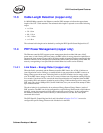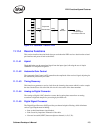
Software Developer’s Manual 199
PHY Functionality and Features
11.10.1 Powerdown via the PHY Register
The PHY can be powered down using the control bit found in PHY register 0d, bit 11. This bit
powers down a significant portion of the port but clocks to the register section remain active. This
enables the PHY management interface to remain active during power-down. The power-down bit
is active high. When the PHY exits software power-down (PHY register 0d, bit 11 = 1b), it re-
initializes all analog functions, but retains its previous configuration settings
.
11.10.2 Smart Power-Down
Smart Power-Down (SPD) is a link-disconnect capability applicable to all power management
states, and is intended for mobile applications. Smart powerdown combines a power saving
mechanism with the fact that link might disappear and resume.
SPD is enabled by PHY register 20d, bit 5 or by the
SPD Enable bit in the EEPROM, and is
entered when the PHY detects link lost. Auto-Negotiation must also be enabled. While in the SPD
state, the PHY powers down circuits and clocks that are not required for detection of link activity.
The PHY is still able to detect link pulses (including parallel detect) and wake up to engage in link
negotiation. The PHY does not send link pulses (NLP) while in the SPD state. Register accesses
are still possible.
Connecting a member of the family to another system with the SPD feature can lead to link failures
if both ports are allowed to enter the SPD state.
11.11 1000 Mbps Operation
11.11.1 Introduction
This section provides an overview of 1000BASE-T functions, followed by discussion and review
of the internal functional blocks shown in Figure 11-3.


















